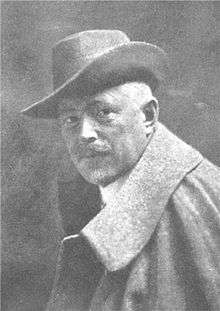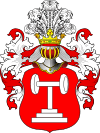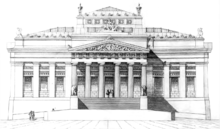Władysław Horodecki
| Władysław Horodecki Владислав Городецький | |
|---|---|
 | |
| Born |
May 23, 1863 Sholudky, Podolia Governorate, Russian Empire (now Ukraine) |
| Died |
January 3, 1930 (aged 66) Tehran, Iran |
| Nationality | Russian Empire, Poland |
| Occupation | Architect |
| Buildings |
House with Chimaeras (Kiev), St. Nicholas Cathedral (Kiev), National Art Museum (Kiev), Karaite Kenesa |
| Design | Art Nouveau, Moorish Revival, and Gothic Revival styles |
|
|
Władysław Horodecki (born Leszek Władysław Dezydery Horodecki, also known under Russian version of his name, Vladislav Gorodetsky; Russian: Владислав Владиславович Городецкий; Ukrainian: Владислав Владиславович Городецький, Vladyslav Vladyslavovych Horodetskyi; June 4 [O.S. May 23] 1863 in Sholudky, Podolia Governorate — January 3, 1930 in Tehran, Iran) was a Polish architect and big-game hunter, best known for his contributions in Kiev urban development with buildings such as the House with Chimaeras, the St. Nicholas Roman Catholic Cathedral, the Karaite Kenesa, the National Art Museum of Ukraine in Kiev, the capital of Ukraine.
In Ukraine Horodecki often worked along with a sculptor from Milan, Emilio Sala, who was an instructor at the Kiev City College.
Brief biography

Ukraine
Horodecki was born into a noble Polish szlachta family of the Kornic coat of arms in the village of Szołudki (Sholudky, now Mukhivtsi Rural Council, Nemyriv Raion, Vinnytsia Oblast). His ancestors were big landowners (didych) in the Podillya region. Horodecki graduated from the Imperial Academy of Arts in St. Petersburg in 1890, while prior to that he finished a realschule in Odessa. After 1890 Horodecki moved to Kiev where he lived for almost 30 years.
Poland
As Poland regained its independence after the Polish-Soviet War in 1920, and Russia, including Kiev, fell under Bolshevism, he emigrated to Warsaw. In Poland Horodecki headed an American Project Bureau "Henry Ulan & Co.". Some of his designs were built including a water tower and trade rows in Piotrków Trybunalski (today in Lodz Voivodeship), a meat factory in Lublin, a bath house in Zgierz, and a casino building in Otwock.
Persia
In 1928 on the invitation of the same company Horodecki moved to Tehran, becoming a chief architect of the Syndicate on the Design of Persian Railways. In 1930 he died and was buried at Doulab Catholic Cemetery in Tehran. His epitaph is inscribed in Polish with only the phrase Profesor architektury. Niech mu obca ziemia będzie lekka., which translates into English as "Professor of architecture. Let the foreign earth will be light for him".
Legacy
One of Kiev's streets, designed by Horodecki,[1] (between Maidan Nezalezhnosti and House with Chimaeras) was named after him in 1996 as vulytsia Arkhitektora Horodetskoho. The street had been no called ulitsa Nikolayevskaya, and in Soviet times it was known as vulytsia Karla Marksa.
Works
References
- ↑ "Photoalbum". Official web-portal (in Ukrainian). Kiev municipal authority. Retrieved 2007-07-15.
External links
| Wikimedia Commons has media related to Władysław Horodecki. |
- Ivanenko, Anna (2004). "Gorodetsky. Lord of Chimaeras". Mir Turizma (in Russian). 1–2. ISSN 1811-3583. Retrieved 2006-09-17. Essay about Horodecki
- "Architect of the century" (in Ukrainian). Vinnytsia oblast' universal science library named after K.A.Timiryazev. 2003-05-20. Archived from the original on 2007-09-28. Retrieved 2007-07-14. Biography of Horodecki


